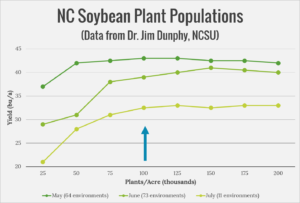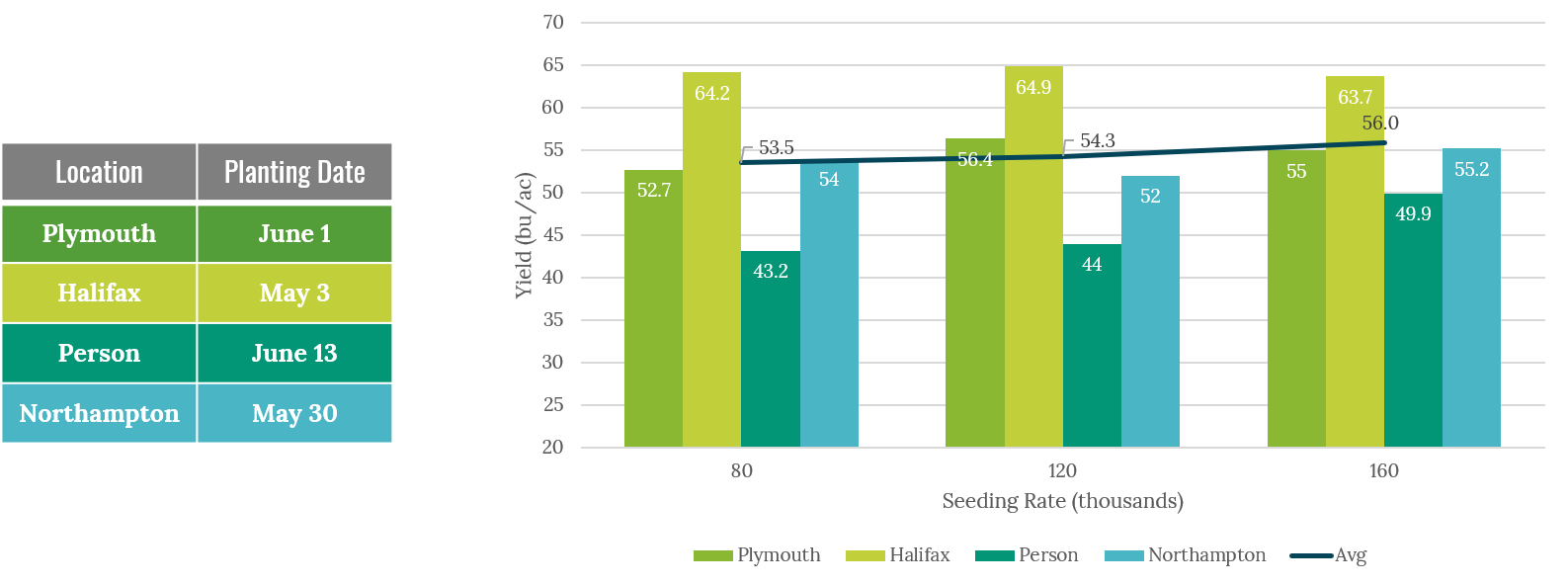We continue our 2018 Management Decisions series this week where we tackle plant populations. At this point, most of you have selected varieties and purchased seed, so one of the next things to think about is soybean seeding rate. Conventional wisdom says planting high populations will ensure maximum yields, but actually, this is not always the case.
Seed is one of the most expensive inputs for soybean growers, so it’s essential to plant the right amount of seed to minimize input costs while still maintaining high yields, ultimately increasing profitability. Numerous seeding rate studies carried out across the U.S. suggest that the optimal plant population for maximum return on investment is 80,000 to 120,000 plants per acre. We’ll take a deeper look at some of this research below.
First, is work carried out by Dr. Dunphy right here in North Carolina evaluating a wide range of plant populations. In the graph below, notice that this is very little yield difference (especially for the earlier planting dates) in the treatments after you pass 100,000 plants per acre, suggesting there is no value in planting higher populations. This work includes data collected from over 50 different environments, meaning it is very reliable.
Next, we look at data from On-Farm Research conducted with NC growers in 2017. This research included a “farm-size” research plots where different populations were planted in different strips across the field. This research was carried out on 4 different farms last season ranging from the Blacklands to the Piedmont. Three different seeding rates were tested (80,000, 120,000, and 160,000 seed).
The planting date for each of these trails is in the table below and average yield for each location is in the chart. The green line at the top of the chart is the average yield across all 4 sites and yield for each individual site is in white at the top of the bar).
Among 3 of the 4 sites, there was very little (if any) increase in yield as populations increased (Plymouth, Halifax, & Northampton). However, at site 3 you will notice there was a significant difference in yield among the populations. The 160k population out-yielded the 80k population by almost 7 bushels. This was a double-crop farm so as expected, we needed a higher population here to help maximize yields.
When averaged across all 4 sites, there is a slight increase in yield as population increases (about 2.5 bu). If I remove the Person site from this average (the outlier since it was the only true double-crop plot) there is less than a bushel difference between the 80k and 160k population.
Average Yield (Plymouth, Halifax, Northampton)
80k: 57.0
120k: 57.7
160k: 57.9
This research demonstrates that soybean plants have the unique ability to adapt and the plants can compensate for a wide range of plant populations. The yield per acre remains relatively constant across planting rates, likely because the seeds produced per plant is inversely related to the number of plants per acre.
So, is a 2 or 3 bushel per acre increase in yield, worth the extra cost of seed? Well, assuming a seed cost of $60 a bag (that’s approximately $0.40 per thousand seed) we can calculate the cost of seed for these populations.
To pay for the cost of going from 100,000 seed/acre to 200,000 you would need to increase yield by 4.3 bu/acre (assuming $10 soybeans). Based on the data collected in North Carolina and across the U.S., we would not expect this may not be a profitable decision.
While reducing seeding rates can help save on input costs, remember to there are times when higher populations may be beneficial (as we saw in our On-Farm research trials). Higher rates are recommended for the following:
- Very early planting
- Late planting (after July 1)
- Low productivity soils
- Planting with a drill
I know many of you are not comfortable going down to 80,000 per acre, and I’m not suggesting you all do that, as you know your fields best. But I would challenge you to try a seeding rate a little lower than you typically use. This is an easy way to save money in tight economic times without sacrificing significant (if any) yield.
Check back next week as we continue of Management Decisions series.










